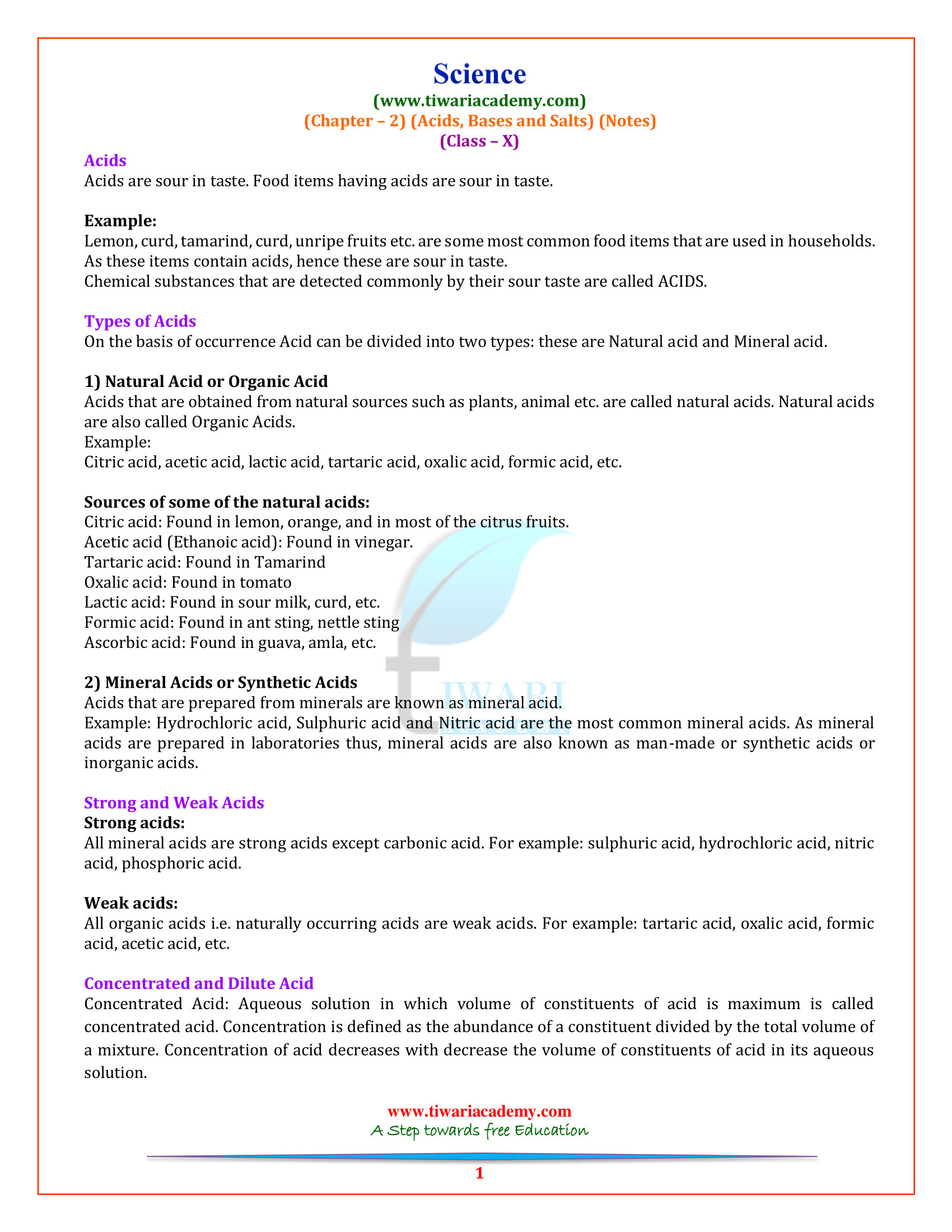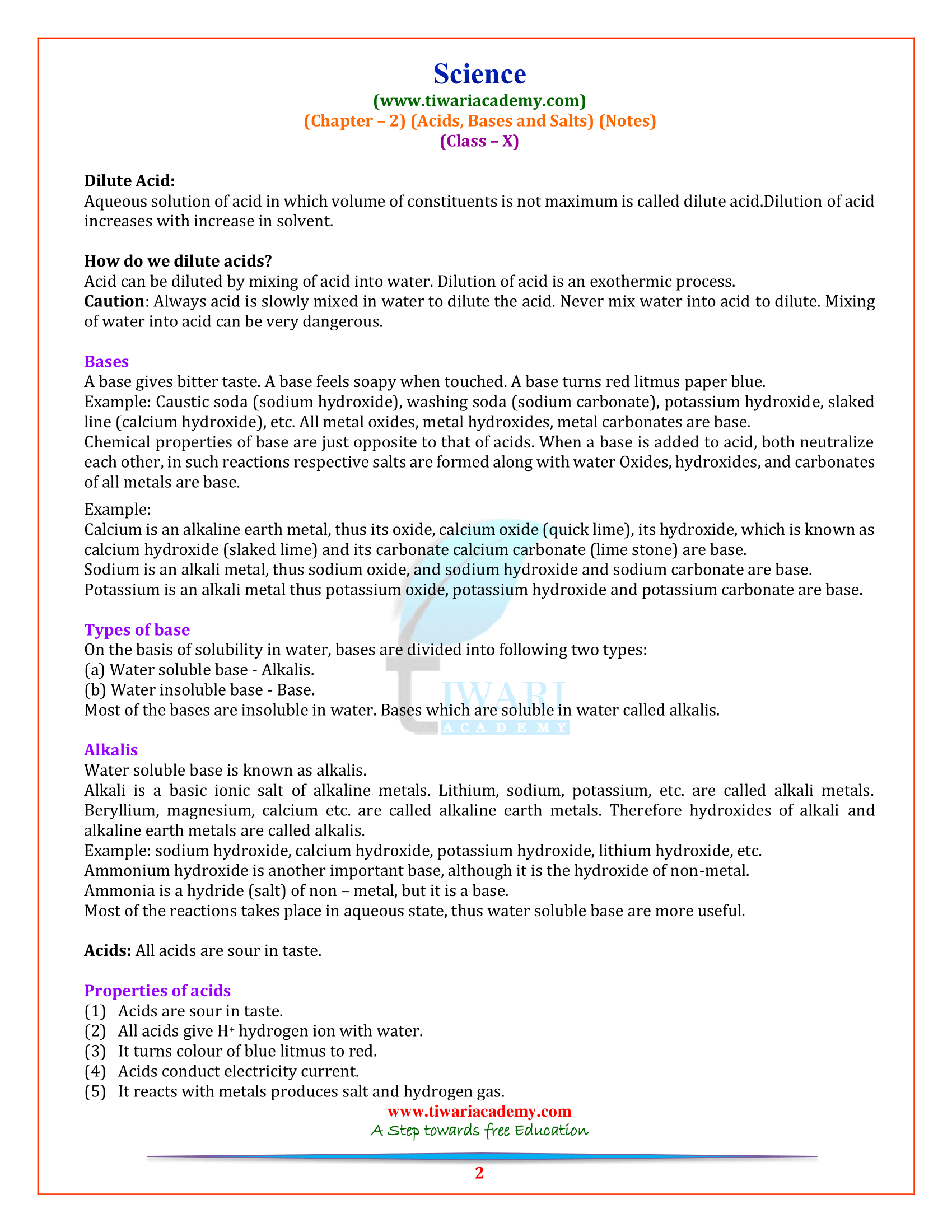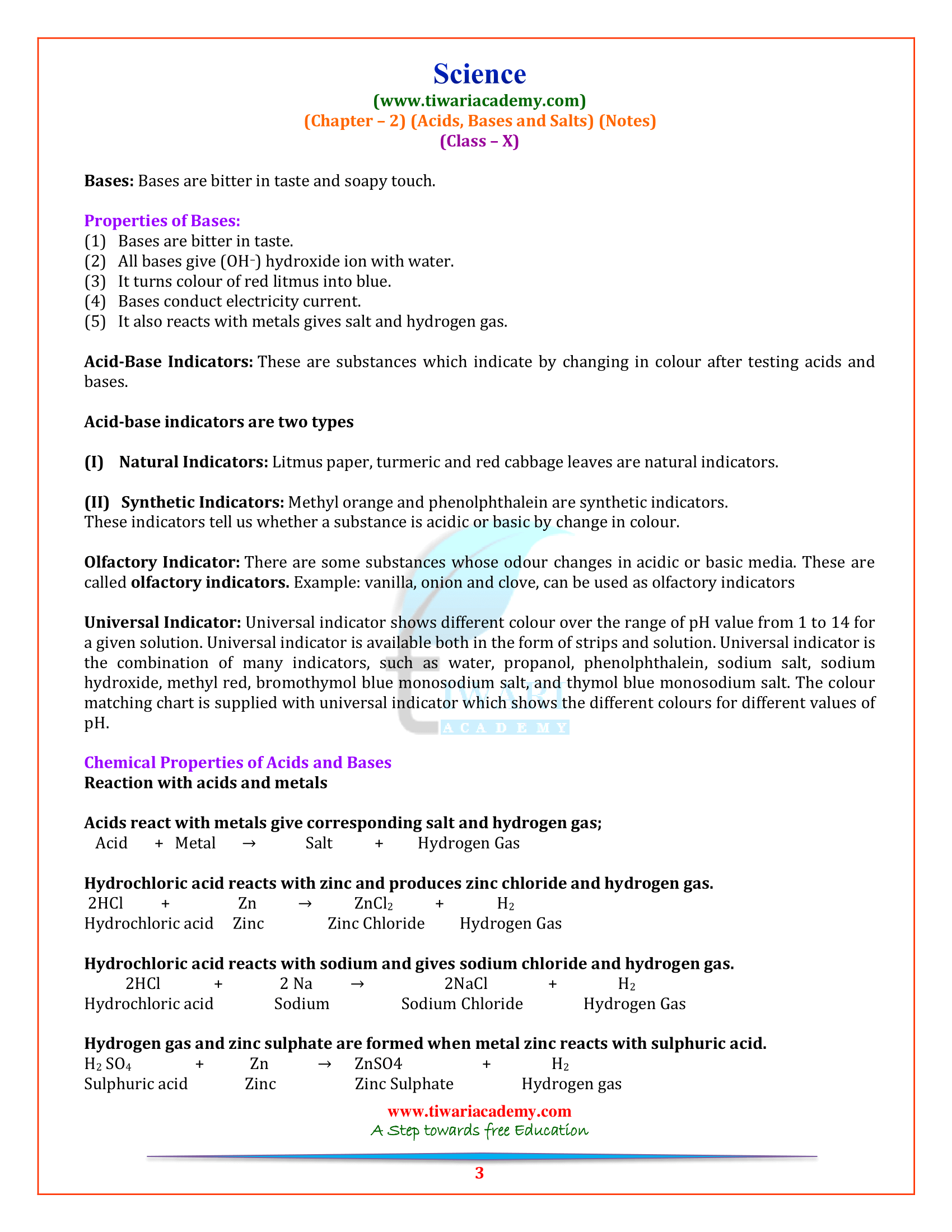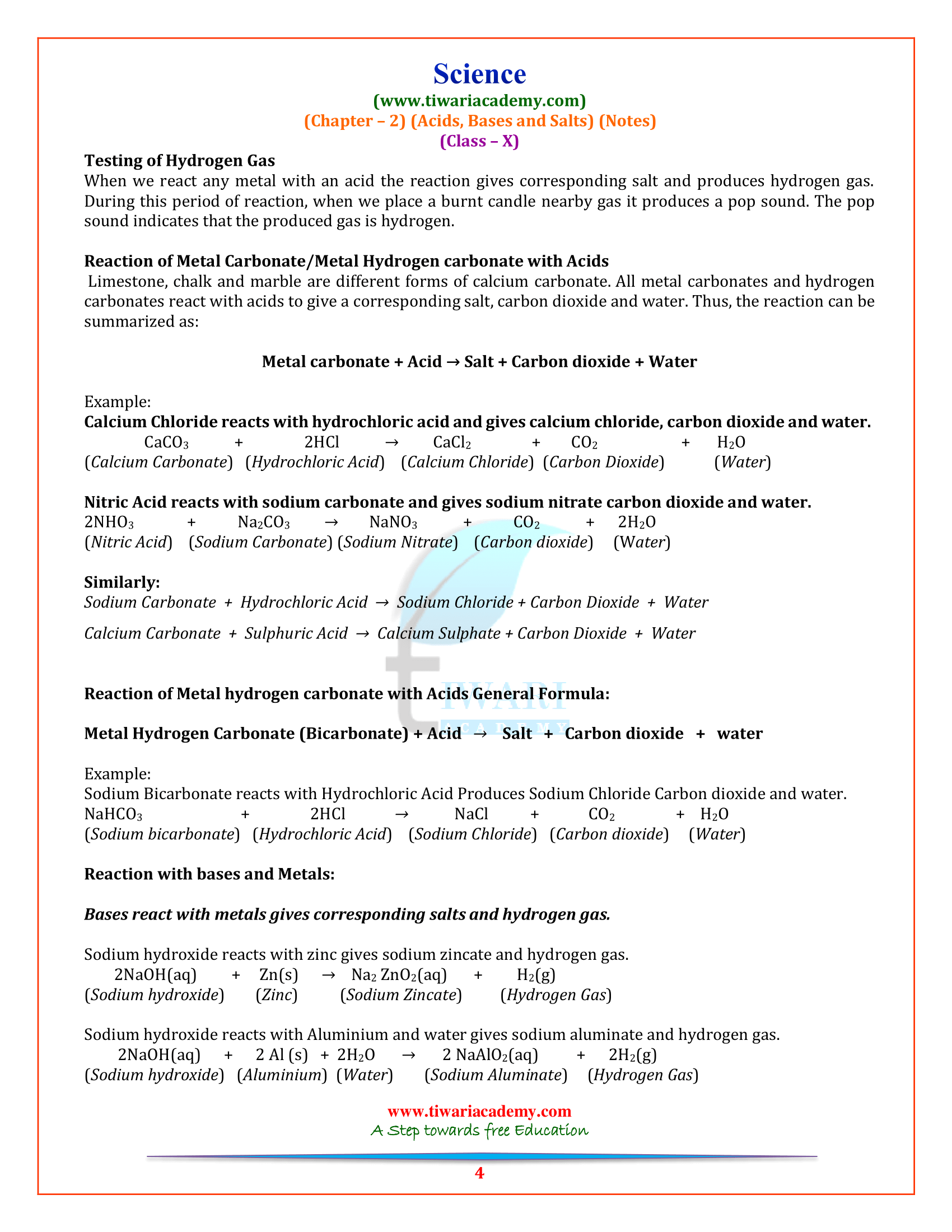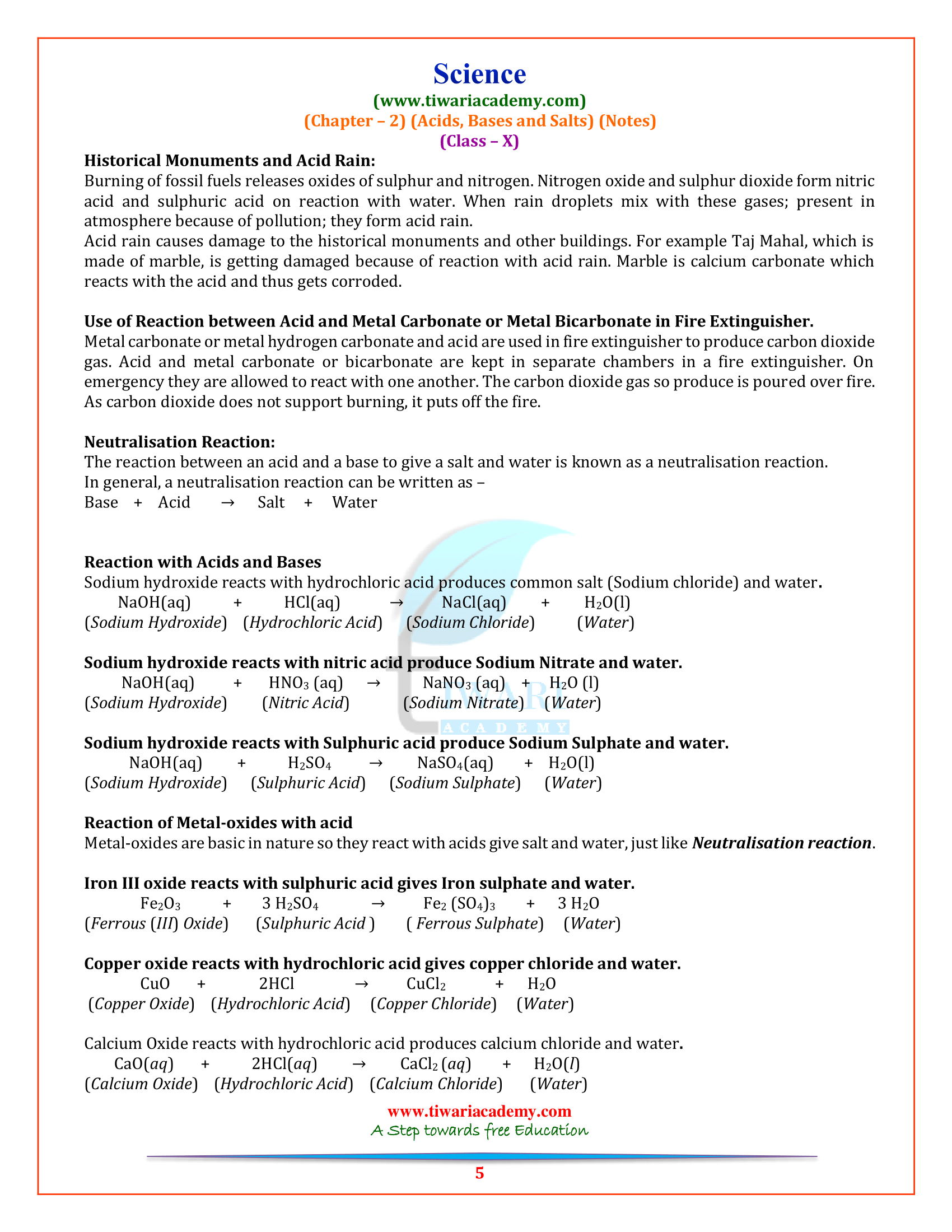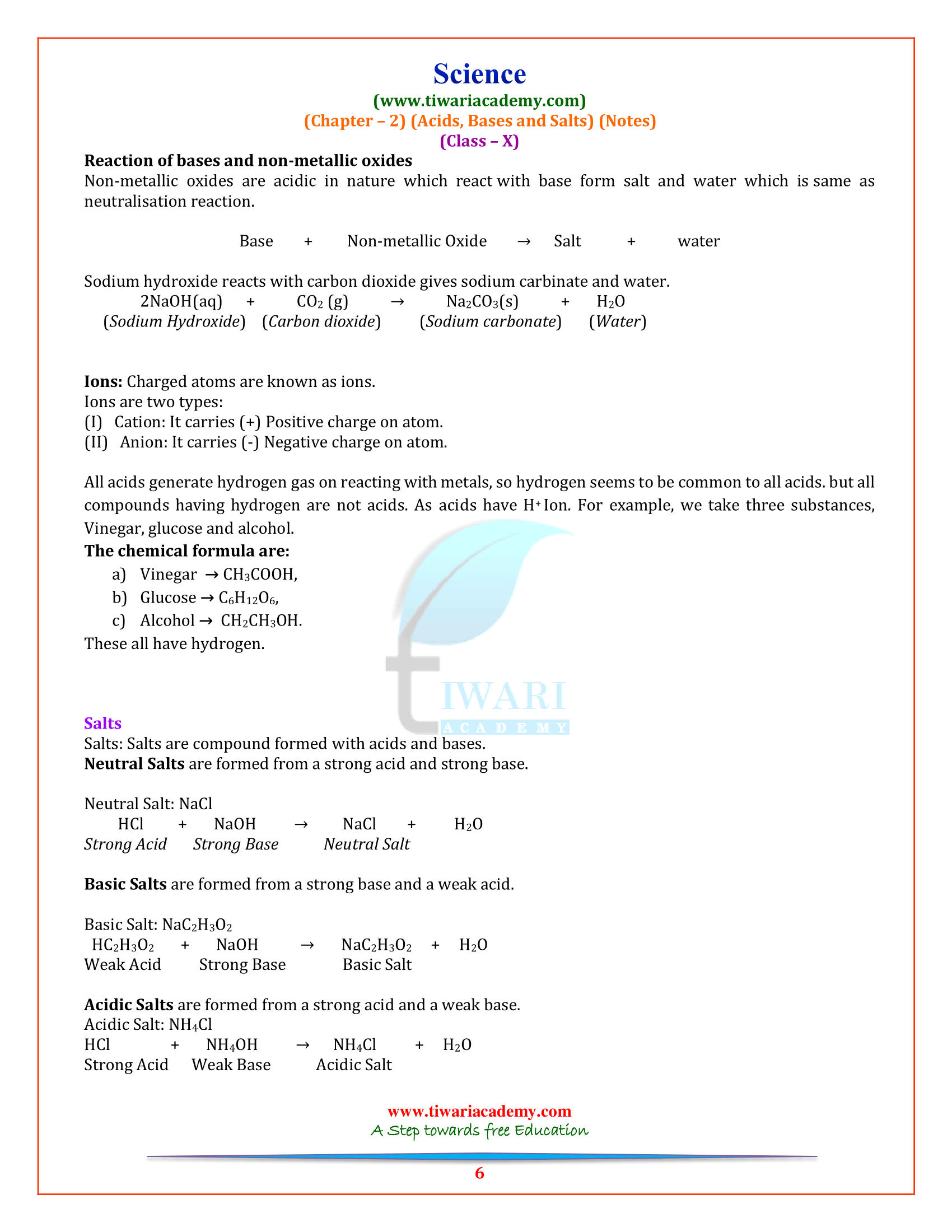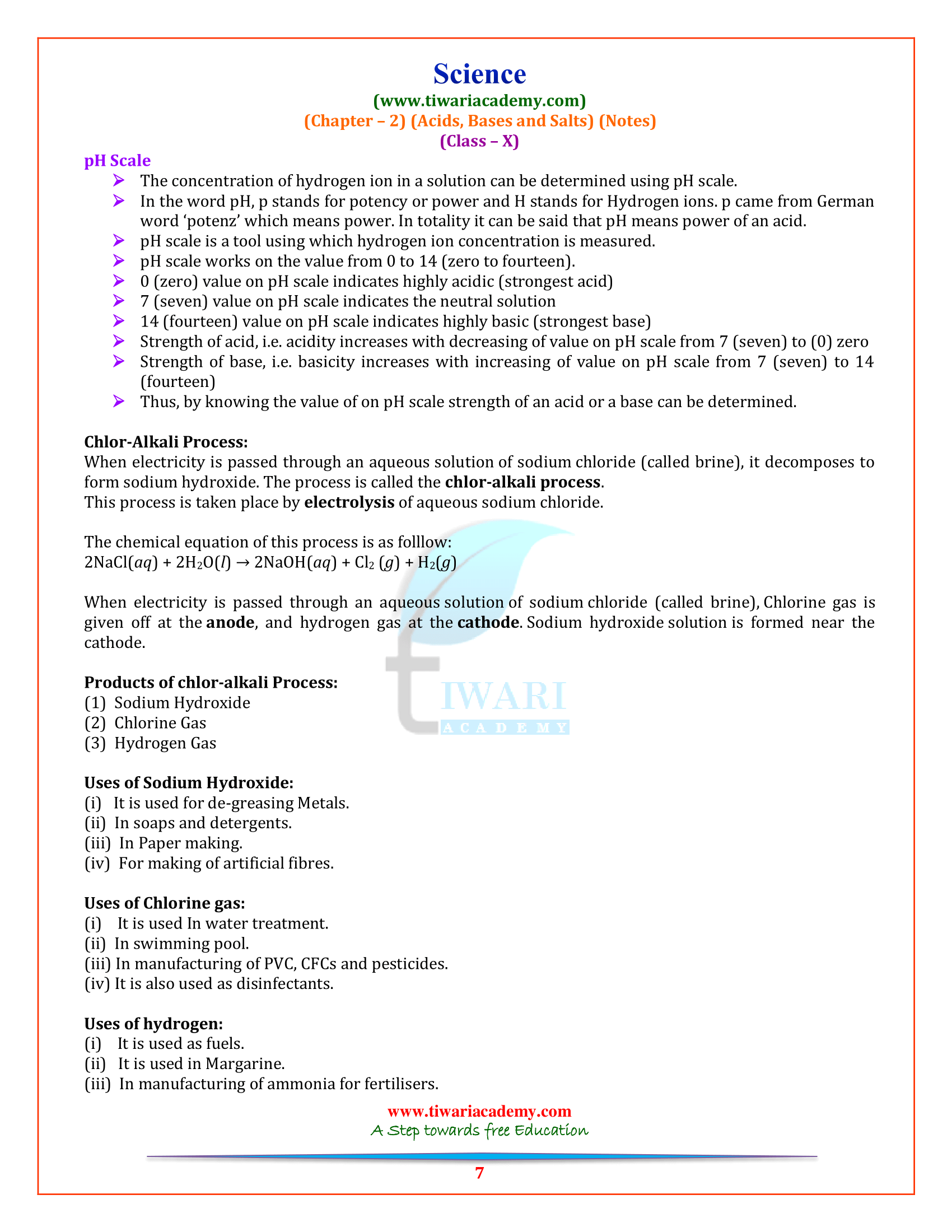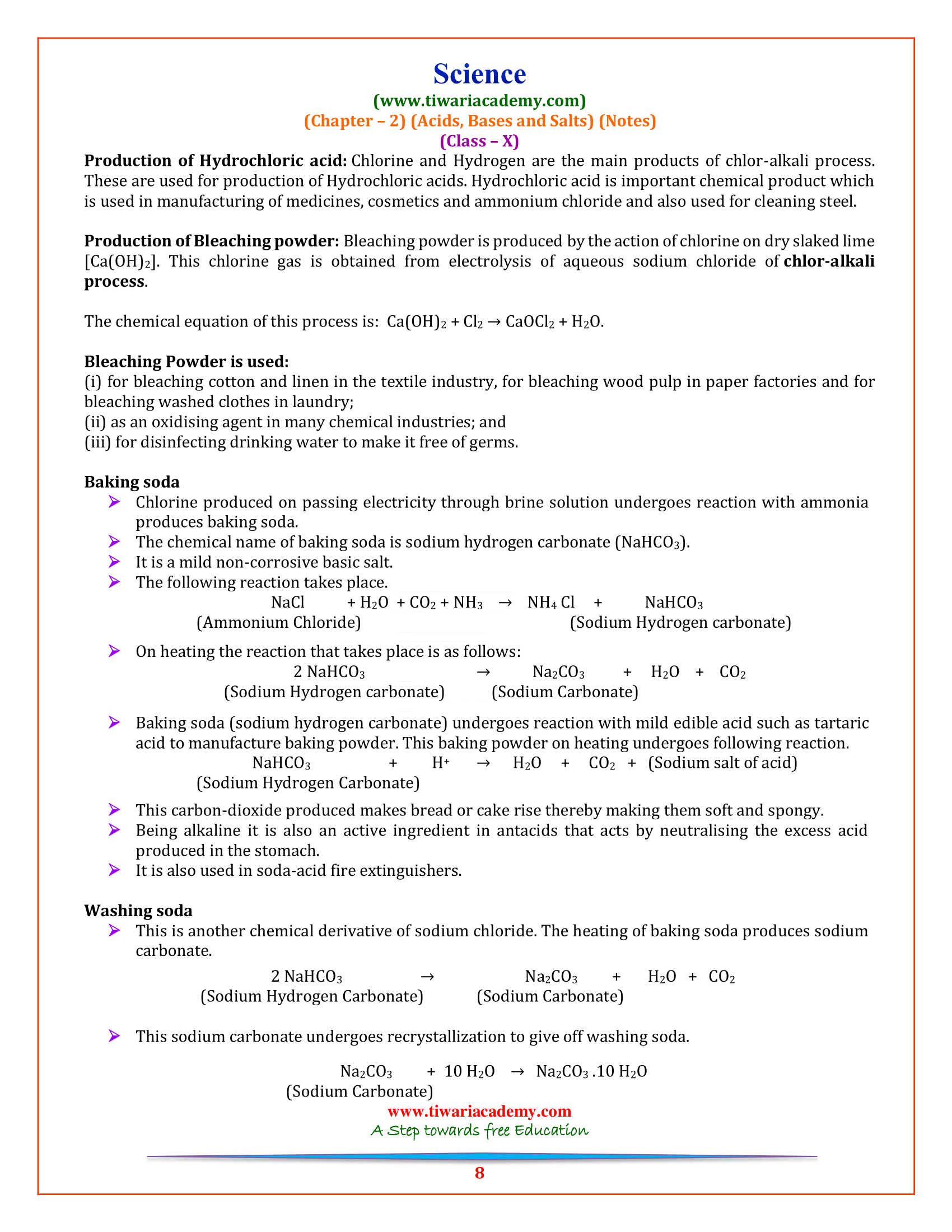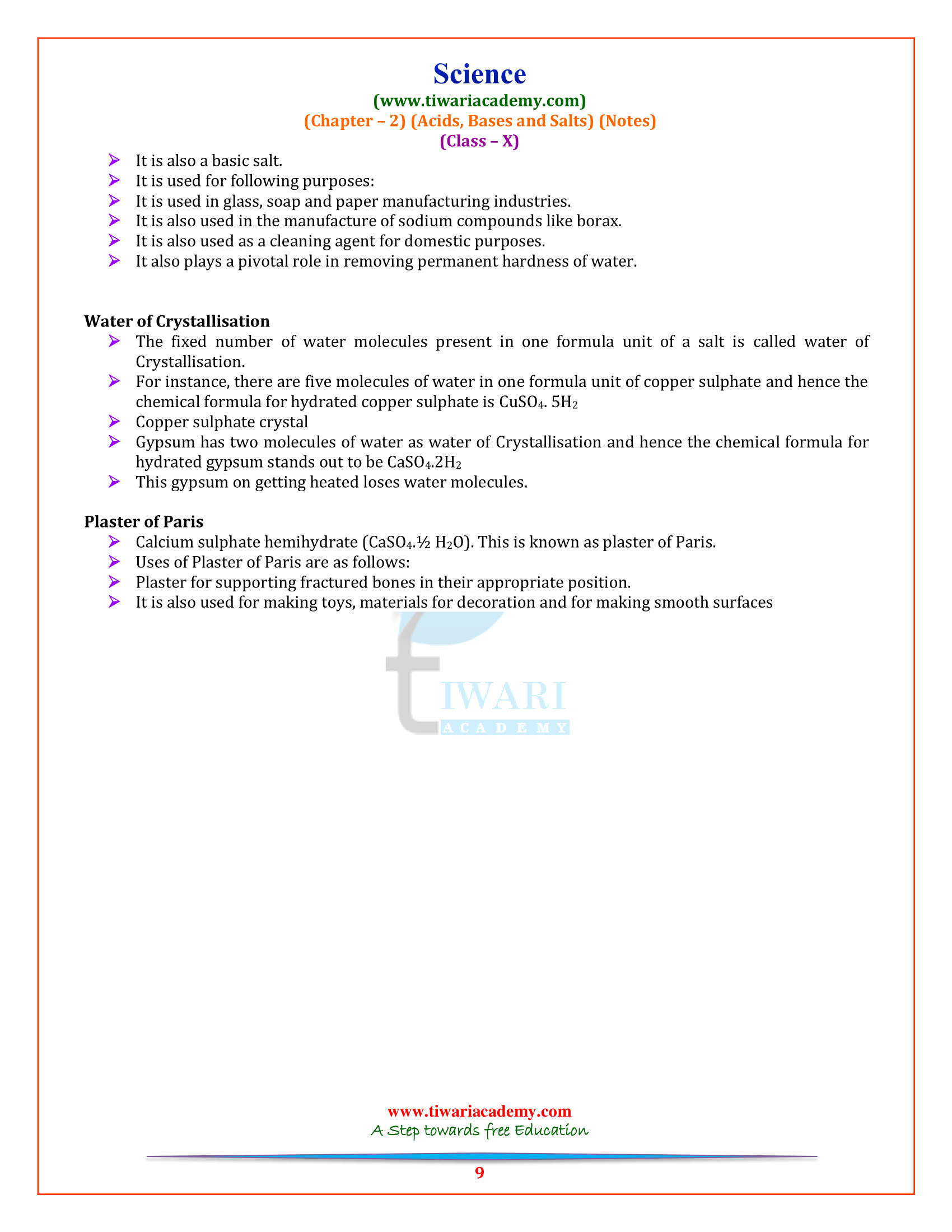Class 10 Science Chapter 2 Notes of Acids, Bases and Salts. Explanation of every important term related to Acids and Bases. These 10th Science Notes are useful for UP Board Students also. In Uttar Pradesh Board, Prayagraj, students of High School are now using NCERT Textbooks for their exam preparation. So, students can use these Class 10 Science Chapter 2 notes for UP Board. The main points of the chapter 2 is covered through these notes. Important Questions and Previous years board questions related to Class 10 Science Chapter 2 are given below with answers. The language for notes is kept very simple and easy, so that everyone can understand. Equations and reactions related to each fact are also taken to describe the definition. For any education help, students can contact us without any hesitation. We are here to help you without any charge.
Class 10 Science Chapter 2 Notes for 2024-25
| Class: 10 | Science |
| Chapter: 2 | 10th Science Notes |
Class 10 Science Chapter 2 Notes for Exams
Prepare Class 10 Science Chapter 2 using simplified Notes with keywords and explanation. All the definition and equations related to 10th Science Chapter 2 Acids, Bases and Salts are given below. Student of UP Board and MP Board also take the benefits of these notes, as they are using NCERT for the new academic session 2024-25.
Sources of Natural Acids
- Citric acid: Found in lemon, orange, and in most of the citrus fruits.
- Acetic acid (Ethanoic acid): Found in vinegar.
- Tartaric acid: Found in Tamarind
- Oxalic acid: Found in tomato
- Lactic acid: Found in sour milk, curd, etc.
- Formic acid: Found in ant sting, nettle sting
- Ascorbic acid: Found in guava, amla, etc.
Difference between Strong and Weak Acids
Strong Acids
All mineral acids are strong acids except carbonic acid. For example: sulphuric acid, hydrochloric acid, nitric acid, phosphoric acid.
Weak Acids
All organic acids i.e. naturally occurring acids are weak acids. For example: tartaric acid, oxalic acid, formic acid, acetic acid, etc.
Dilution of Acids
Acid can be diluted by mixing of acid into water. Dilution of acid is an exothermic process.
Caution: Always acid is slowly mixed in water to dilute the acid. Never mix water into acid to dilute. Mixing of water into acid can be very dangerous.
Bases
A base gives bitter taste. A base feels soapy when touched. A base turns red litmus paper blue.
Example: Caustic soda (sodium hydroxide), washing soda (sodium carbonate), potassium hydroxide, slaked line (calcium hydroxide), etc. All metal oxides, metal hydroxides, metal carbonates are base.
Chemical properties of base are just opposite to that of acids. When a base is added to acid, both neutralize each other, in such reactions respective salts are formed along with water Oxides, hydroxides, and carbonates of all metals are base.
Example:
Calcium is an alkaline earth metal, thus its oxide, calcium oxide (quick lime), its hydroxide, which is known as calcium hydroxide (slaked lime) and its carbonate calcium carbonate (lime stone) are base.
Sodium is an alkali metal, thus sodium oxide, and sodium hydroxide and sodium carbonate are base.
Potassium is an alkali metal thus potassium oxide, potassium hydroxide and potassium carbonate are base.
Types of base
On the basis of solubility in water, bases are divided into following two types:
- (a) Water soluble base – Alkalis.
- (b) Water insoluble base – Base.
Most of the bases are insoluble in water. Bases which are soluble in water called alkalis.
Do you know, what is an alkali?
Water soluble base is known as alkalis.
Alkali is a basic ionic salt of alkaline metals. Lithium, sodium, potassium, etc. are called alkali metals. Beryllium, magnesium, calcium etc. are called alkaline earth metals. Therefore hydroxides of alkali and alkaline earth metals are called alkalis.
Example: sodium hydroxide, calcium hydroxide, potassium hydroxide, lithium hydroxide, etc.
Ammonium hydroxide is another important base, although it is the hydroxide of non-metal.
Ammonia is a hydride (salt) of non – metal, but it is a base.
Most of the reactions takes place in aqueous state, thus water soluble base are more useful.
Properties of acids
- Acids are sour in taste.
- All acids give H+ hydrogen ion with water.
- It turns colour of blue litmus to red.
- Acids conduct electricity current.
- It reacts with metals produces salt and hydrogen gas.
Properties of Bases
- Bases are bitter in taste.
- All bases give (OH–) hydroxide ion with water.
- It turns colour of red litmus into blue.
- Bases conduct electricity current.
- It also reacts with metals gives salt and hydrogen gas.
Historical Monuments and Acid Rain
Burning of fossil fuels releases oxides of sulphur and nitrogen. Nitrogen oxide and sulphur dioxide form nitric acid and sulphuric acid on reaction with water. When rain droplets mix with these gases; present in atmosphere because of pollution; they form acid rain.
Acid rain causes damage to the historical monuments and other buildings. For example Taj Mahal, which is made of marble, is getting damaged because of reaction with acid rain. Marble is calcium carbonate which reacts with the acid and thus gets corroded.
pH Scale
The concentration of hydrogen ion in a solution can be determined using pH scale. In the word pH, p stands for potency or power and H stands for Hydrogen ions. p came from German word ‘potenz’ which means power. In totality it can be said that pH means power of an acid.
- pH scale is a tool using which hydrogen ion concentration is measured.
- pH scale works on the value from 0 to 14 (zero to fourteen).
- 0 (zero) value on pH scale indicates highly acidic (strongest acid)
- 7 (seven) value on pH scale indicates the neutral solution
- 14 (fourteen) value on pH scale indicates highly basic (strongest base)
- Strength of acid, i.e. acidity increases with decreasing of value on pH scale from 7 (seven) to (0) zero
- Strength of base, i.e. basicity increases with increasing of value on pH scale from 7 (seven) to 14 (fourteen)
- Thus, by knowing the value of on pH scale strength of an acid or a base can be determined.
Chlor-Alkali Process:
When electricity is passed through an aqueous solution of sodium chloride (called brine), it decomposes to form sodium hydroxide. The process is called the chlor-alkali process.
This process is taken place by electrolysis of aqueous sodium chloride.
The chemical equation of this process is as folllow:
2NaCl(aq) + 2H2O(l) → 2NaOH(aq) + Cl2 (g) + H2(g)
When electricity is passed through an aqueous solution of sodium chloride (called brine), Chlorine gas is given off at the anode, and hydrogen gas at the cathode. Sodium hydroxide solution is formed near the cathode.
Products of chlor-alkali Process:
- (1) Sodium Hydroxide
- (2) Chlorine Gas
- (3) Hydrogen Gas
Uses of Sodium Hydroxide
- (i) It is used for de-greasing Metals.
- (ii) In soaps and detergents.
- (iii) In Paper making.
- (iv) For making of artificial fibres.
Uses of hydrogen
Production of Hydrochloric acid: Chlorine and Hydrogen are the main products of chlor-alkali process. These are used for production of Hydrochloric acids. Hydrochloric acid is important chemical product which is used in manufacturing of medicines, cosmetics and ammonium chloride and also used for cleaning steel.
- (i) It is used as fuels.
- (ii) It is used in Margarine.
- (iii) In manufacturing of ammonia for fertilisers.
Uses of Chlorine gas
- It is used In water treatment.
- In swimming pool.
- In manufacturing of PVC, CFCs and pesticides.
- It is also used as disinfectants.
Revision Questions for 10th Science Chapter 2
What is Universal Indicator?
Universal indicator shows different colour over the range of pH value from 1 to 14 for a given solution. Universal indicator is available both in the form of strips and solution. Universal indicator is the combination of many indicators, such as water, propanol, phenolphthalein, sodium salt, sodium hydroxide, methyl red, bromothymol blue monosodium salt, and thymol blue monosodium salt. The colour matching chart is supplied with universal indicator which shows the different colours for different values of pH.
How do you test the presence of Hydrogen Gas in a reaction?
When we react any metal with an acid the reaction gives corresponding salt and produces hydrogen gas. During this period of reaction, when we place a burnt candle nearby gas it produces a pop sound. The pop sound indicates that the produced gas is hydrogen.
Why do we use Metal Carbonate or Metal Bicarbonate in Fire Extinguisher?
Metal carbonate or metal hydrogen carbonate and acid are used in fire extinguisher to produce carbon dioxide gas. Acid and metal carbonate or bicarbonate are kept in separate chambers in a fire extinguisher. On emergency they are allowed to react with one another. The carbon dioxide gas so produce is poured over fire. As carbon dioxide does not support burning, it puts off the fire.
What do you understand by Ions?
Charged atoms are known as ions.
Ions are two types:
(I) Cation: It carries (+) Positive charge on atom.
(II) Anion: It carries (-) Negative charge on atom.
